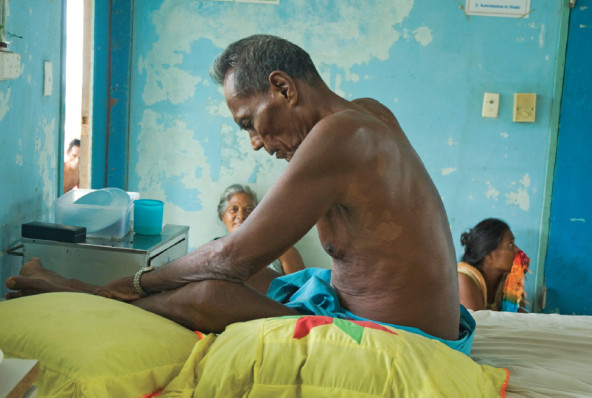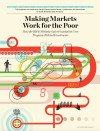 A man is examined for tuberculosis at the Kiribati Hospital in the island nation of the Republic of Kiribati. (Photograph by Lorrie Graham)
A man is examined for tuberculosis at the Kiribati Hospital in the island nation of the Republic of Kiribati. (Photograph by Lorrie Graham)
In its work on sleeping sickness, malaria, tuberculosis, and other diseases, the Bill & Melinda Gates Foundation noticed that many of its global health partners were getting promising results from their work with a small biotech company in Palo Alto, Calif. Whereas most biotech companies looked for carbon molecules, Anacor Pharmaceuticals Inc. had found a novel way to develop drugs based on boron and precisely target them in the human body.
Making Markets Work for the Poor

This special supplement examines how the Bill & Melinda Gates Foundation uses program-related investments—loans, equity stakes, and guarantees—to complement its traditional grant making.
-
Philanthropy’s New Tools for Innovation and Impact
-
Leveraging the Balance Sheet
-
Neglected No More
-
Unintended Consequences
-
Banking on the Poor
-
Guaranteed Impact
-
Investing for Impact with Program-Related Investments
-
Tough Love
-
Eyes Wide Open
-
Returns on Investment
-
Private Financing for Public Education
In a partnership with the neglected disease initiative of Médecins Sans Frontières, Anacor had developed a promising drug for sleeping sickness, which affects people living in three dozen African countries. All told, a half-dozen Gates Foundation-funded partners, including the Medicines for Malaria Venture, the TB Alliance, and OneWorld Health, had worked with Anacor to evaluate the potential of boron-based compounds.
That progress caught the attention of the Gates Foundation just as its global health team was shifting its drug-discovery strategy away from disease-specific initiatives. Instead, the foundation was looking for partners with the best technology platforms that could be applied broadly across a range of diseases in the hope of finding promising candidates for drug development.
To gain access to the company’s unique platform for the benefit of neglected diseases, the Gates Foundation in 2013 reached an agreement with Anacor for a broad research program, ultimately funded with $18.3 million in contracts. The agreement focused the boron platform on developing new drugs for tuberculosis, river blindness, lymphatic filariasis (commonly known as elephantiasis), and other diseases.
Once the research project came into focus, the challenge was structuring the financing. The research funding provided Anacor with non-dilutive capital to expand its early-stage efforts in global health. But the company was also looking for a broader equity investment from the Gates Foundation. Helping seal the deal was an additional $5 million investment in Anacor’s Nasdaq-traded common stock that gave the foundation a 2 percent equity stake in the company. It was the foundation’s first program-related investment (PRI) in a publicly traded company.
Global Access
The Gates Foundation’s investment came two-and-a-half years after Anacor’s initial public offering (IPO) of stock in 2011. The price of the company’s shares hadn’t risen much since the IPO. Like many development-stage biotechnology companies, Anacor needed cash to support its research and clinical development. It was still more than a year away from the US Food and Drug Administration’s approval of its first product, Kerydin, a toenail antifungal treatment.
Some biotech companies, particularly young ones, are eager to take on contracts to do early-stage research that demonstrates their technology prowess. Anacor had discovered a number of molecules for the potential treatment of infectious diseases caused by bacteria, fungi, and parasites, including one with potential for treating tuberculosis under a partnership with GlaxoSmithKline.
Anacor would welcome the implicit validation that would come with a Gates Foundation partnership, which would allow it to develop its technology platform further while addressing the unmet needs of neglected diseases. The partnership would also provide entry to the foundation’s network of researchers.
Under the proposed three-year research agreement, Anacor would focus on developing drugs for tuberculosis, river blindness, and elephantiasis, diseases affecting millions of people in the developing world. The contract called for the discovery of two preclinical drug candidates for macrofilaricides, an adult worm-killing drug, and one advanced lead compound for tuberculosis. The team would later add another target disease, cryptosporidiosis, a leading cause of pediatric death due to diarrhea in the developing world.
There were opportunity costs to pursuing such research, however. The Gates Foundation’s research proposal would commit Anacor to three years of research that was unlikely to yield profitable products. There are market-based reasons that tuberculosis remains a human catastrophe that has infected nearly a third of the planet and kills 1.5 million people each year.
“Anyone who is familiar with TB research and development realizes there hasn’t been very much activity in the past 40 years because it’s extremely difficult,” says Eric Easom, head of neglected diseases at Anacor. “TB drugs are not often viewed as commercial drivers for large pharmaceutical companies.” Even if a successful tuberculosis drug could achieve revenues meaningful to a biotechnology startup, he says, “It may not be worth the opportunity cost for the major players in the pharmaceutical industry.”
Having the Gates Foundation on board as a shareholder would also send a positive signal to the public markets about the value of Anacor’s technology. Equity would provide a fresh source of financing to the company, and gaining a $5 million commitment from a single investor was an attractive proposition.
“I thought it was important for the Gates Foundation to make an investment. If we didn’t have the equity investment, I didn’t think the company would get over the threshold and do the deal,” says venture capitalist Paul Klingenstein, a founder and managing director at Aberdare Ventures, who was on Anacor’s board at the time of the foundation’s investment. “We were very slow to embrace any of the non-commercial disease targets, without understanding the benefits to Anacor.”
In the end, says Klingenstein, “The company determined that the transaction was in the best interests of Anacor and its shareholders and we did it.”
In the two-and-a-half years the [Gates] foundation held its stake, Anacor's market value soared from $221 million to roughly $4.5 billion.
From the Gates Foundation’s perspective, an equity investment in Anacor’s core platform would help the foundation secure “global access” rights to any products developed for the neglected diseases. The legally binding rights were outlined in a side-letter agreement that required Anacor to sell the products produced with foundation funding at an affordable price in developing countries. Anacor would also make its expanded library of boron compounds available to the Gates Foundation as well as academic, governmental, and nonprofit researchers. Such rights are often easier to get through an equity investment than through grants, says David Rossow, a program investment officer at the foundation.
“It was our team’s belief that this was a novel platform,” Rossow says. “Anacor also had an interest in and passion for neglected diseases. And because they were a relatively small biotech company, they were willing to work with the foundation.”
“Companies tend to massively overvalue their intellectual property,” he explains. “If we said, ‘We want to license your IP on these targets, in these countries,’ they would likely demand more than the IP is worth.”
Win-Win
Anacor’s share price, which had been drifting downward, rose modestly on the news of the Gates Foundation’s investment. But the subsequent run-up in Anacor’s share price had little to do with the company’s work in global health or with Anacor’s partnership with the foundation.
Anacor made steady progress on the research effort. Six months after the Gates Foundation’s investment, Anacor was designing and adding more than a compound a week to its boron-compound library, ultimately creating 900 new molecules with drug potential. The company worked with technical experts at the foundation to evaluate extremely early in vitro and in vivo data to identify compounds with promise against river blindness and elephantiasis. Last year, Anacor allowed Gates Foundation partners to evaluate much of its boron-compound library to determine whether these molecules have potential against priority target diseases.
Coincidentally, Anacor’s stock market performance in the same period was driven by progress in bringing its late-stage commercial drug assets to market. First, the company got a favorable ruling in its arbitration with Valeant Pharmaceuticals and reached a settlement agreement in which Valeant paid Anacor $142 million. Investors now believed Anacor had the cash to complete its development work and bring Kerydin, its lead product development candidate, to market; its stock rose more than 20 percent in the month following the announcement.
In July 2014, Anacor announced that it had entered into an agreement with a division of Sandoz Inc., to distribute and commercialize Kerydin in the United States. And last year, Anacor announced positive phase 3 clinical results for another product candidate, crisaborole, for the treatment of atopic dermatitis. The stock soared 65 percent the week following the announcement.
The Gates Foundation had stumbled onto a significant financial return.
Since that time, progress has continued on the neglected-disease research work. Anacor has identified molecules for the potential treatment of river blindness and elephantiasis. The company also identified promising antibacterial compounds for the treatment of tuberculosis. Work continues on cryptosporidiosis.
With the charitable goals of the investment ensured, the Gates Foundation was free to sell the bulk of its equity stake, with the exception of a small position that secures access to the firm’s library of boron compounds through 2018. The foundation sold all but 1 percent of its holdings in November 2015.
In selling, the Gates Foundation gained $86.7 million, or approximately 17 times its initial investment. In the two-and-a-half years the foundation held its stake, Anacor’s market value soared from $221 million to roughly $4.5 billion.
Unexpected Challenge
Traditional venture investors typically face criticism when they lose money on a deal. Philanthropic and impact investors can face criticism when they make money. In taking an equity stake in Anacor in addition to providing funding through the contract, the Gates Foundation took a broad risk as part of a high-level partnership to deploy Anacor’s capabilities on otherwise neglected diseases. And with risk comes the possibility of reward.
“If you’re going to go and collaborate with these young engines of innovation seeking capital, make the broad bet,” says Klingenstein.
The US Internal Revenue Service (IRS) rules for PRIs state that financial returns cannot be a significant purpose of a PRI. But tax regulations don’t prohibit financial gains as an unintended consequence. The financial outcome of the Anacor investment was indeed a side effect of the foundation’s charitable purpose and strategic thesis.
It happens that some of the world’s best technologies for global health are held by small companies that may achieve outsize financial returns. As fulfilling as it may be, research on neglected diseases may divert resources from these companies’ core mission of commercializing drug candidates that might deliver a blockbuster drug that rewards shareholders. In those cases, equity investments can help align the incentives of private companies with the goals of the foundation.
Unlike a traditional venture capitalist, of course, any returns from PRIs go back to the foundation for philanthropic purposes. Pursuant to IRS rules, the profits from the investment will go back to the foundation’s overall endowment; the returned principal must be redistributed through grants, contracts, or other PRIs within one year.
“The fact that the foundation’s equity investment in Anacor has generated some positive financial returns that we’ve then been able to turn around and use to try to eradicate polio in Pakistan, to me is icing on the cake,” says Julie Sunderland, the former director of the Gates Foundation’s PRI team.
“But it’s not why we do it,” says Sunderland. “We do it because we want to partner with great entrepreneurs and great companies and great scientists and develop low-cost products for the poor. The focus on achieving results for our beneficiaries is clear in every investment we do.”
Support SSIR’s coverage of cross-sector solutions to global challenges.
Help us further the reach of innovative ideas. Donate today.
Read more stories by Dennis Price & David Bank.

